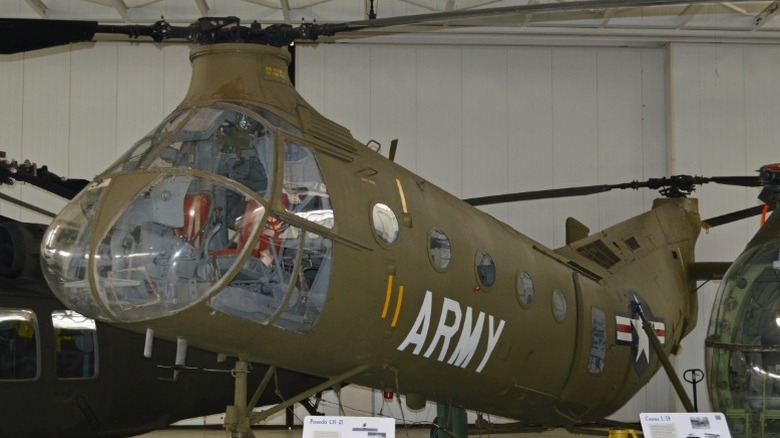Why Is This Military Helicopter Called The Flying Banana?
The hard-working, multi-role Piasecki H-21 helicopter, known as the "Flying Banana," was the brainchild of Frank Piasecki, who founded the P-V Engineering Forum alongside his college buddy, Harold Venzie, in 1940. At the time, helicopters were still in their infancy and viewed with skepticism, so it should come as no surprise that their backstory is just as colorful as the nickname.
Piasecki, who was always fascinated with flying, figured that a helicopter with tandem rotors could be a game-changing workhorse, but it would take a few years before it would get off the ground. The duo's first helicopter was a single-seat, single-rotor helicopter (the PV-2) that rolled out in 1943, built as a technology demonstrator to prove the aircraft actually worked. It was quite literally only the second chopper to ever fly in the United States; the first was military aviation hero Igor Sikorsky's VS-300 in 1939. Piasecki was also the very first person in the U.S. to receive a helicopter pilot's license.
The development of the H-21 occurred in stages, starting with experimental iterations dubbed the XHRP-1 and XHRP-2, which were both equipped with tandem rotor configurations (one in the front and another in the rear). Piasecki intentionally designed an odd bend in the rear fuselage that angled up so the overlapping tandem rotors wouldn't hit the fuselage during flight. In every sense, it made the helicopter look like a flying banana, and the nickname stuck. The bent "flying banana" fuselage design became a defining characteristic for this particular line of Piasecki helicopters.
The U.S. military wasn't keen on flying a banana at first
When World War II broke out, Piasecki got his chance to show off his tandem rotor idea. However, it wasn't the U.S. military that was first interested. Instead, it was the Coast Guard, which needed a heavy transport helicopter with a bigger payload and strong engine to rescue crews aboard torpedoed ships along the East Coast of United States.
Simply put, the U.S. Navy wasn't ready to take a chance on what was considered a new and untested aircraft. Plus, the Navy didn't think Piasecki's concept could fulfill its 1,800-pound useful load requirement. The Coast Guard, however, placed an order for one on New Year's Day, 1944. The Navy's wariness suddenly faded, and they quickly ordered two of their own, in turn becoming the first helicopter developed under a U.S. military contract.
The P-V Engineering Forum went to work but didn't produce the first flight test XHRP-1 (experimental, helicopter, transport, Piasecki, model one) until June 1947. It was christened the "Dogship" because it was merely a mock-up without a fabric cover. The second XHRP-1 was only used for static testing. They were three times larger than any other chopper in the air at the time, thus making them the world's largest (and only) tandem-rotor helicopters — which happened to also look like flying bananas. It wasn't Piasecki's only quirky aircraft, either; he also created the X-49 Speedhawk, another chopper that made our list of the 10 strangest-looking military helicopters ever.
The Flying Banana paved the way for the Chinook
The prototypes were so successful that Piasecki ditched the "experimental" tag and built twenty new HRP-1s. The first of these took flight in August 1947 and continued until the end of 1950. As the Flying Banana became more prevalent, the Coast Guard, Navy, and Marines all field-tested it in various situations, and its usefulness as a combat and rescue aircraft became clear. Much like the experimental version, the production HRP-1 could seat ten (or six stretchers) and lift 2,000 pounds of cargo. Upgrades made it possible for the wheels on the tricycle-style landing gear to get swapped out for floats or skis.
The twelve that served with the Marine Corps between 1948 and 1950 were assigned to Marine Helicopter Squadron (HMX) 1 and were used to help develop the first vertical assault tactics. The H-21, which was a successor to the HRP-1, set altitude and speed records for the Air Force, which convinced the Army to buy several (then) new H-21C "Shawnees." The Air Force used these extensively during the Vietnam War as its first assault helicopters because it was capable of transporting a full infantry squad. Unfortunately, on February 4, 1961, a "Shawnee" tragically became the first U.S. helicopter shot down in Vietnam.
Boeing acquired the Piasecki Helicopter Corporation in 1960, becoming the former's helicopter division and specializing in manufacturing large helicopters. A total of 707 H-21 Flying Bananas were built, and it is regarded as the forefather of Boeing's highly regarded CH-47 Chinook.

